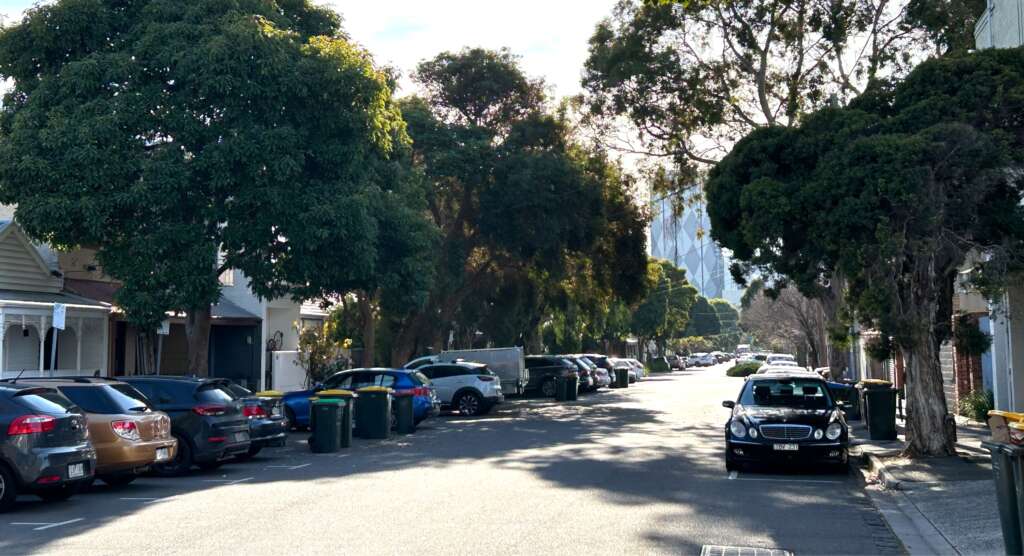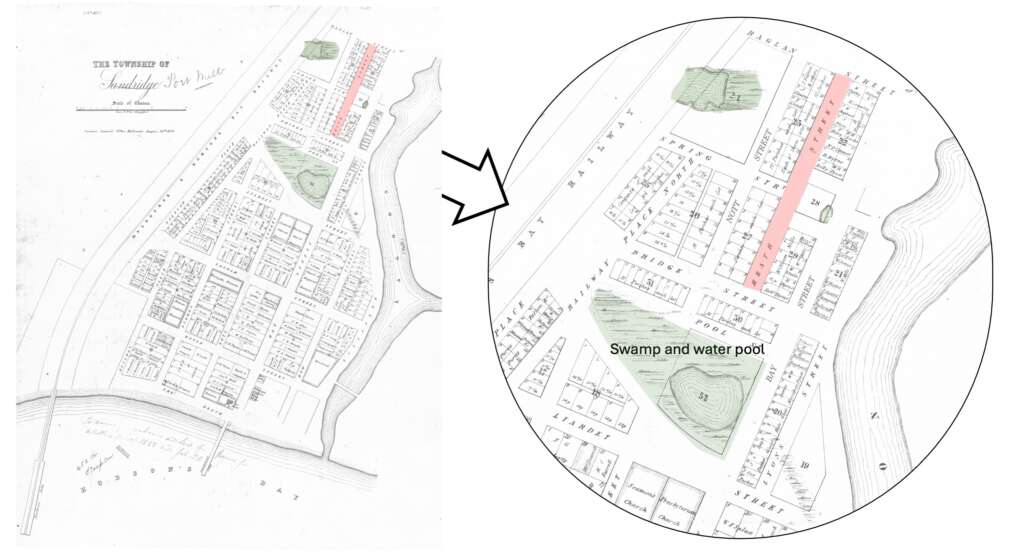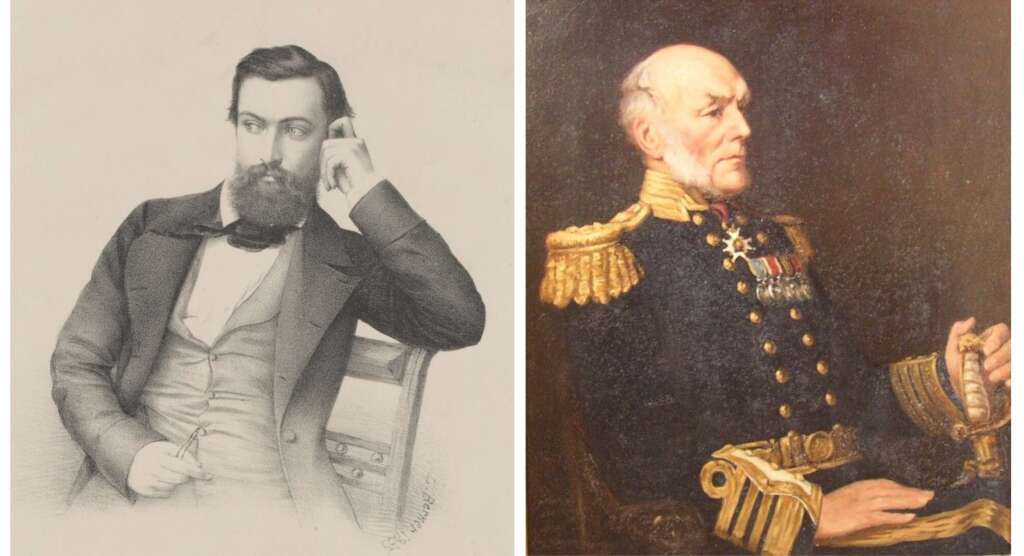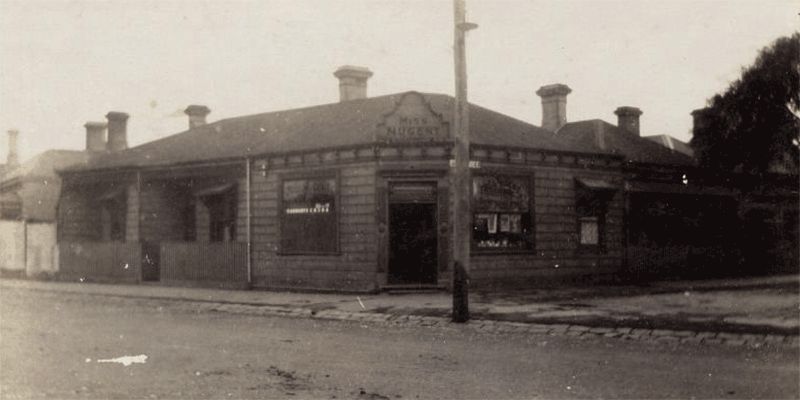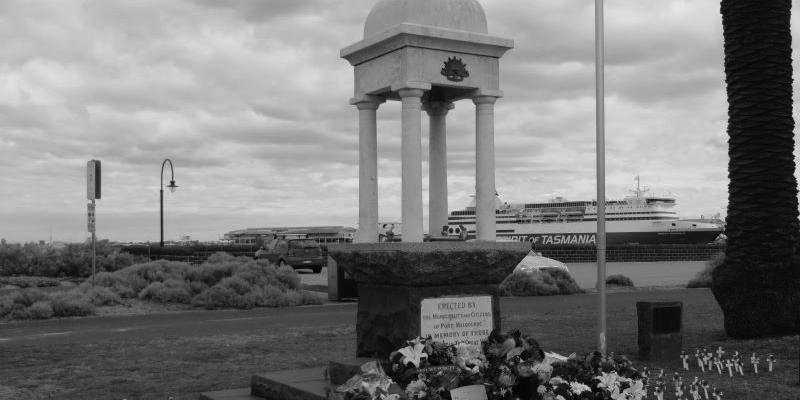Heath Street
by David F Radcliffe
The eclectic range of architectural styles and the pleasant canopy of trees along Heath Street conceal its part in the shaping of Sandridge in the gold fever fuelled 1850s. Apart from its residents, few traverse this quiet street except if they are going to or from the Port Melbourne Town Hall and Library via Spring Street, North or South.
Initially, Sandridge was confined to the area south of Liardet Street. Immediately north of this lay swampy land and several water holes. When the goldrush population boom forced the expansion of Sandridge, the planners leapfrogged the swampy ground, creating two new east-west streets north of it, Bridge and Raglan, in the narrow gap between the Hobsons Bay Railway and the Lagoon. The access way behind Bridge Street was appropriately called Pool Street.
In the resulting subdivision published by the Surveyor General’s Department in 1856, Heath Street formed its spine. As seen in the map below, Bay and Nott Streets were projected northward to Raglan Street with Heath Street placed between them to provide increased street frontage to the Crown Land allotments created in Sections 22, 23, 27 and 29. Indicative of the boom underway, these building allotments were much smaller than the those auctioned only a couple of years earlier in Sandridge between Rouse, Dow, Liardet and Stokes Streets.
The area north of the swamp continued to grow, taking on a distinct identity as North Sandridge. In February 1859, a new stop was added to the Hobsons Bay Railway at the end of Raglan Street. In 1860, as Sandridge became a separate municipality, plans were drawn up to extend Heath Street beyond Raglan, over Ingles Street and as far as Boundary Street, the northern border with Emerald Hill. In 1867, the railway station was renamed from Raglan Street to North Sandridge.[1]
The question remains, where does the name Heath come from? While it would be a fitting tribute to Arthur V Heath who served variously as Town Clerk and City Engineer for Port Melbourne the timing is not right as his career was from the late 1880s until 1920.[2] There seems to be two possible candidates: George Poynter Heath and Leopold George Heath.
The case for George Poynter Heath is weak. He was a marine surveyor who worked in Australian waters on the HMS Rattlesnake and the surveyor community are known to name things for each other. There is a tenuous link between him and John Lort Stokes after whom, Stokes Street seems to have been named. However, the main claims to fame for George Poynter Heath relate to Queensland and these occurred from the late 1850s.
Conversely, a good case can be made for Leopold George Heath. During the Crimean War (Oct 1853-Feb 1856), he captained the San Pareil and was later in charge of the port of Balaclava.[3] At the time, the Surveyor General of Victoria was Andrew Clarke, who had taken over when Robert Hoddle retired in 1853. Between 1853 and 1857 Clarke oversaw a massive amount of planning occasioned by the population pressures of the gold rush. In this capacity, he was well acquainted with Sandridge, so much so that the local movers and shakers petitioned him in 1856 to stand as their MLA.[4] However, the locals were not so impressed with him when the Montague area was excised from the Macarthur Ward, the ward encompassing Sandridge in the Melbourne Corporation.[5]
Clarke trained in the Royal Engineers and when war broke out in the Crimea, he wrote a letter to London seeking to gain a new commission and serve in the campaign.[6] Although his request was not granted, his eagerness and the attention he paid to the conflict, as displayed in his correspondence provides a strong circumstantial case for why the names of three streets that appeared on these plans for Sandridge in 1856 are all linked to the Crimean Campaign – Raglan, Lyons and Heath.
Further research may provide definitive evidence one way or the other about the naming of Heath Street. Meanwhile, it is worth taking a closer look at the many contributions Andrew Clarke made to Victoria, not only as Surveyor General shaping the places we inhabit but also helping to shape the Constitution of the new State and fostering its scientific and intellectual foundations through initiating the Philosophical Society which morphed into the Royal Society of Victoria.
[1] After the name of the suburb changed from Sandridge to Port Melbourne, so the station became North Port.
[2] 1939 ‘MR. A. V. HEATH DIES IN TASMANIA’, Record (Emerald Hill, Vic. : 1881 – 1954), 2 December, p. 2. , viewed 28 Jun 2024, http://nla.gov.au/nla.news-article164484667
[3] Sir Leopold George Heath, Letters from the Black Sea during the Crimean War 1854-55, Richard Bentley & Son, London, 1897.
[4] 1856 ‘PUBLIC MEETING OF ELECTORS AT SANDRIDGE.’, The Age (Melbourne, Vic. : 1854 – 1954), 23 April, p. 3. , viewed 28 Jun 2024, http://nla.gov.au/nla.news-article154863886
[5] 1857 ‘THE PEOPLE AND THE HAINES CABINET.’, Bendigo Advertiser (Vic. : 1855 – 1918), 16 March, p. 2. , viewed 28 Jun 2024, http://nla.gov.au/nla.news-article87997928
[6] Col. R. H. Vetch (Ed) Life of Lieut.-General the Hon. Sir Andrew Clarke, John Murray, Albemarle Street, London, 1905, pp. 45-49.

